- Playing asteroids: Analyzing samples retrieved from a near-Earth asteroid Wiley Analytical Science
- Mineralogical evidence for hydrothermal alteration of Bennu samples Nature
- Bennu’s contents are older than the Solar System Universe Space Tech
- Asteroid sample found with the help of Canadian instrument predates our solar system Fort Frances Times
- Insights from Asteroid Bennu: What OSIRIS-REx sample return has revealed Estes Park Trail-Gazette
Category: 7. Science
-
Playing asteroids: Analyzing samples retrieved from a near-Earth asteroid – Wiley Analytical Science
-
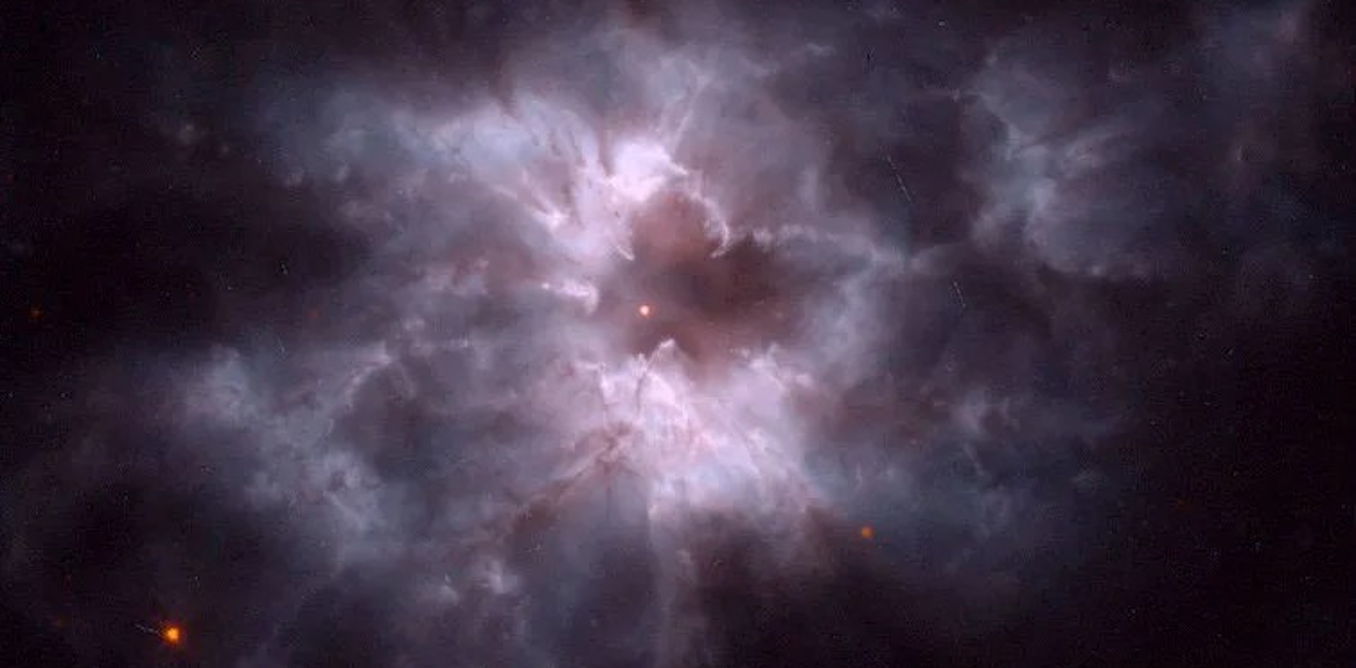
Earth-size stars and alien oceans – an astronomer explains the case for life around white dwarfs
The Sun will someday die. This will happen when it runs out of hydrogen fuel in its core and can no longer produce energy through nuclear fusion as it does now. The death of the Sun is often thought of as the end of the solar system. But in reality, it may be the beginning of a new phase of life for all the objects living in the solar system.
When stars like the Sun die, they go through a phase of rapid expansion called the Red Giant phase: The radius of the star gets bigger, and its color gets redder. Once the gravity on the star’s surface is no longer strong enough for it to hold on to its outer layers, a large fraction – up to about half – of its mass escapes into space, leaving behind a remnant called a white dwarf.
I am a professor of astronomy at the University of Wisconsin-Madison. In 2020, my colleagues and I discovered the first intact planet orbiting around a white dwarf. Since then, I’ve been fascinated by the prospect of life on planets around these, tiny, dense white dwarfs.
Researchers search for signs of life in the universe by waiting until a planet passes between a star and their telescope’s line of sight. With light from the star illuminating the planet from behind, they can use some simple physics principles to determine the types of molecules present in the planet’s atmosphere.
In 2020, researchers realized they could use this technique for planets orbiting white dwarfs. If such a planet had molecules created by living organisms in its atmosphere, the James Webb Space Telescope would probably be able to spot them when the planet passed in front of its star.
In June 2025, I published a paper answering a question that first started bothering me in 2021: Could an ocean – likely needed to sustain life – even survive on a planet orbiting close to a dead star?
Despite its relatively small size, a white dwarf – shown here as a bright dot to the right of our Sun – is quite dense.
Kevin Gill/Flickr, CC BY
A universe full of white dwarfs
A white dwarf has about half the mass of the Sun, but that mass is compressed into a volume roughly the size of Earth, with its electrons pressed as close together as the laws of physics will allow. The Sun has a radius 109 times the size of Earth’s – this size difference means that an Earth-like planet orbiting a white dwarf could be about the same size as the star itself.
White dwarfs are extremely common: An estimated 10 billion of them exist in our galaxy. And since every low-mass star is destined to eventually become a white dwarf, countless more have yet to form. If it turns out that life can exist on planets orbiting white dwarfs, these stellar remnants could become promising and plentiful targets in the search for life beyond Earth.
But can life even exist on a planet orbiting a white dwarf? Astronomers have known since 2011 that the habitable zone is extremely close to the white dwarf. This zone is the location in a planetary system where liquid water could exist on a planet’s surface. It can’t be too close to the star that the water would boil, nor so far away that it would freeze.
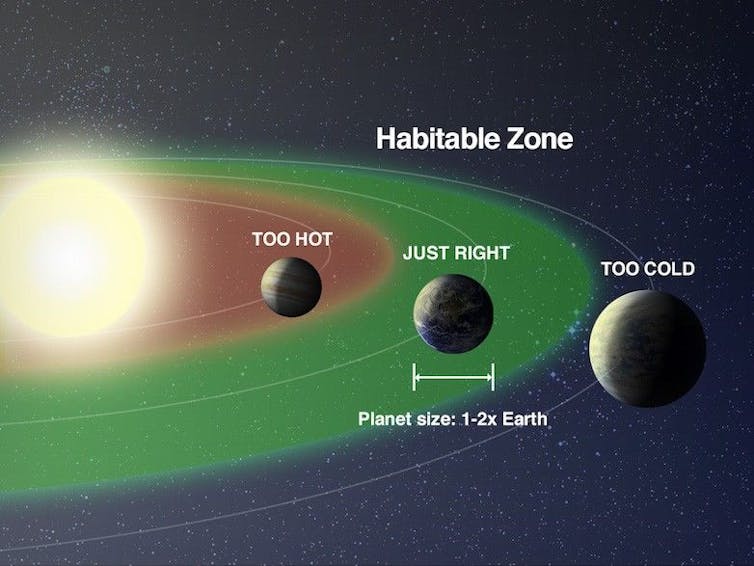
Planets in the habitable zone aren’t so close that their surface water would boil, but also not so far that it would freeze.
NASA
The habitable zone around a white dwarf would be 10 to 100 times closer to the white dwarf than our own habitable zone is to our Sun, since white dwarfs are so much fainter.
The challenge of tidal heating
Being so close to the surface of the white dwarf would bring new challenges to emerging life that more distant planets, like Earth, do not face. One of these is tidal heating.
Tidal forces – the differences in gravitational forces that objects in space exert on different parts of a nearby second object – deform a planet, and the friction causes the material being deformed to heat up. An example of this can be seen on Jupiter’s moon Io.
The forces of gravity exerted by Jupiter’s other moons tug on Io’s orbit, deforming its interior and heating it up, resulting in hundreds of volcanoes erupting constantly across its surface. As a result, no surface water can exist on Io because its surface is too hot.
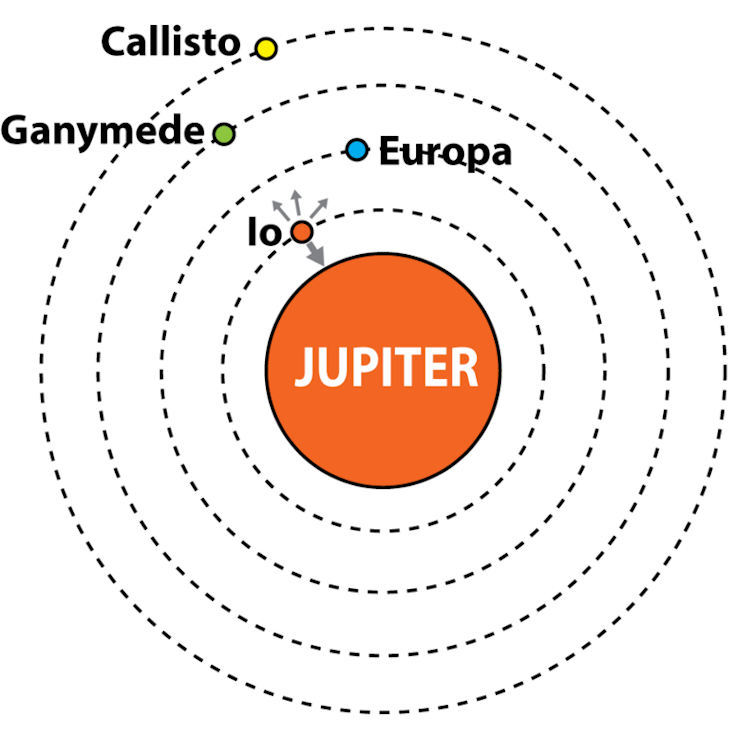
Of the four major moons of Jupiter, Io is the innermost one. Gravity from Jupiter and the other three moons pulls Io in varying directions, which heats it up.
Lsuanli/Wikimedia Commons, CC BY-SA
In contrast, the adjacent moon Europa is also subject to tidal heating, but to a lesser degree, since it’s farther from Jupiter. The heat generated from tidal forces has caused Europa’s ice shell to partially melt, resulting in a subsurface ocean.
Planets in the habitable zone of a white dwarf would have orbits close enough to the star to experience tidal heating, similar to how Io and Europa are heated from their proximity to Jupiter.
This proximity itself can pose a challenge to habitability. If a system has more than one planet, tidal forces from nearby planets could cause the planet’s atmosphere to trap heat until it becomes hotter and hotter, making the planet too hot to have liquid water.
Enduring the red giant phase
Even if there is only one planet in the system, it may not retain its water.
In the process of becoming a white dwarf, a star will expand to 10 to 100 times its original radius during the red giant phase. During that time, anything within that expanded radius will be engulfed and destroyed. In our own solar system, Mercury, Venus and Earth will be destroyed when the Sun eventually becomes a red giant before transitioning into a white dwarf.
For a planet to survive this process, it would have to start out much farther from the star — perhaps at the distance of Jupiter or even beyond.
If a planet starts out that far away, it would need to migrate inward after the white dwarf has formed in order to become habitable. Computer simulations show that this kind of migration is possible, but the process could cause extreme tidal heating that may boil off surface water – similar to how tidal heating causes Io’s volcanism. If the migration generates enough heat, then the planet could lose all its surface water by the time it finally reaches a habitable orbit.
However, if the migration occurs late enough in the white dwarf’s lifetime – after it has cooled and is no longer a hot, bright, newly formed white dwarf – then surface water may not evaporate away.
Under the right conditions, planets orbiting white dwarfs could sustain liquid water and potentially support life.
Search for life on planets orbiting white dwarfs
Astronomers haven’t yet found any Earth-like, habitable exoplanets around white dwarfs. But these planets are difficult to detect.
Traditional detection methods like the transit technique are less effective because white dwarfs are much smaller than typical planet-hosting stars. In the transit technique, astronomers watch for the dips in light that occur when a planet passes in front of its host star from our line of sight. Because white dwarfs are so small, you would have to be very lucky to see a planet passing in front of one.
The transit technique for detecting exoplanets requires watching for the dip in brightness when a planet passes in front of its host star. Nevertheless, researchers are exploring new strategies to detect and characterize these elusive worlds using advanced telescopes such as the Webb telescope.
If habitable planets are found to exist around white dwarfs, it would significantly broaden the range of environments where life might persist, demonstrating that planetary systems may remain viable hosts for life even long after the death of their host star.
Continue Reading
-
NSF National Solar Observatory Welcomes 2025 Brinson Postdoctoral Fellow in Solar Physics
Newswise — Maui, HI, August 28, 2025 — The U.S. National Science Foundation (NSF) National Solar Observatory (NSO) and The Brinson Foundation are proud to announce that Dr. Souymaranjan Dash has been named a Brinson Postdoctoral Fellow in Solar Physics. This prestigious recognition is awarded by The Brinson Foundation to early-career scientists who pursue bold, creative research in their respective fields. This is the second such fellowship in solar physics at NSO, after the one received by Dr. Ryan French in 2022. Dr. Dash’s fellowship begins September 1, 2025.
The new fellow, Dr. Dash, works on understanding the evolution of magnetic fields on the Sun and other stars using data-driven numerical magnetohydrodynamic simulations—magnetohydrodynamics is the science of how electrically charged fluids move when they are affected by magnetic fields. He will join NSO scientist Dr. Tom Schad’s team at the NSF Daniel K. Inouye Solar Telescope, built and operated by NSO. During his graduate work, he extensively worked on predicting global solar coronal magnetic field configurations using data-inspired numerical models during total solar eclipses. Most recently, he worked as a Postdoctoral Fellow at the University of Hawai’i at Mānoa where he developed algorithms to both infer and constrain numerical model parameters by combining numerical models and observations.
Dr. Dash comments on the exciting opportunity ahead: “I’m excited to join the NSO as a Brinson Fellow and to study the magnetic structure and dynamics of the solar corona by combining high-resolution data from the Inouye Solar Telescope with numerical models and theoretical analysis. My work aims to improve our understanding of the magnetic processes that shape solar activity.”
The Brinson Foundation and NSO’s Commitment to Scientific Advancement
The Brinson Foundation is a privately funded philanthropic organization dedicated to supporting cutting-edge research. By providing grants to top research institutions, like NSO, it ensures that emerging talented scientists receive the necessary resources and institutional support to push the boundaries of their fields. As Jamie Bender, Senior Program Officer at the Foundation, stated: “We support early-career scientists who challenge conventional wisdom with innovative ideas. By investing in ambitious research, we aim to foster discoveries that have a lasting impact on our understanding of the universe.”
Partnerships like this allow NSO to increase its reach in studying the Sun, its activity, and its effects on Earth. The fellowship is co-sponsored by NSO via research funds allocated to the NSF Daniel K. Inouye Solar Telescope. Dr. Dave Boboltz, NSO Associate Director at the Inouye, highlighted the importance of supporting early-career scientists in solar research: “The NSF Inouye Solar Telescope enables groundbreaking discoveries about the Sun’s complex behavior. The Brinson Postdoctoral Fellowship ensures that talented scientists like Dr. Dash and Dr. French have the opportunity to harness these capabilities at NSO to further our understanding of solar physics.”
The Science Ahead
During his tenure at NSO, Dr. Dash will focus on studying the Sun’s upper atmosphere through unique observations from both the Inouye and space-based missions, such as Solar Orbiter and the Parker Solar Probe. Special emphasis will be placed on experiments conducted during the April 8, 2024, total solar eclipse, when the elusive corona was visible to millions in the continental U.S. for a few minutes.
Dr. Schad underscored the significance of these observations: “The Sun’s mysteriously hot corona forms the launch point of the dynamic space environment that interacts with Earth. The new capabilities offered by the Inouye, combined with coordinated eclipse experiments, open an exciting frontier for the next generation of solar physicists.”
A Successful First Experience
Dr. French joined as the first Brinson Postdoctoral Fellow at NSO in 2022 after earning his PhD at the UCL Mullard Space Science Laboratory in the UK. His research at NSO has focused on the study of solar flares, explosive events in the Sun’s atmosphere that release massive amounts of energy and influence space weather.
Before his departure, Dr. French reflected on his tenure at NSO: “The Brinson Postdoctoral Fellowship has been a fantastic opportunity to lead my own research in solar physics. Furthermore, The Brinson Foundation provided many professional development opportunities, including in data visualization, science communication, and media training.” Beyond his scientific achievements, Dr. French is an experienced science communicator and author, and received the 2024 Solar Physics Division of the American Astronomical Society Popular Media Award.
Dr. Maria Kazachenko, NSO Scientist and University of Colorado Boulder (CU) Assistant Professor, emphasized Dr. French’s impact on her team: “Thanks to The Brinson Postdoctoral Fellowship, my research group at NSO was able to hire a rising star of solar physics. As a Brinson Fellow, Dr. French led several studies on solar flares, supervised students, taught undergraduate courses, and participated in outreach eclipse trips in Texas.”
The Brinson Postdoctoral Fellowship continues to be a catalyst for pioneering research in solar physics at NSO. As fellows like Dr. Dash, and before him, Dr. French keep pushing the boundaries of our understanding of solar phenomena, their contributions will shape the field for years to come.
###
About the U.S. NSF National Solar Observatory
The mission of the NSF National Solar Observatory (NSO) is to advance knowledge of the Sun, both as an astronomical object and as the dominant external influence on Earth, by providing forefront observational opportunities to the research community.
NSO built and operates the world’s most extensive collection of ground-based optical and infrared solar telescopes and auxiliary instrumentation— including the NSF GONG network of six stations around the world, and the world’s largest solar telescope, the NSF Daniel K. Inouye Solar Telescope—allowing solar physicists to probe all aspects of the Sun, from the deep solar interior to the photosphere, chromosphere, the outer corona, and out into the interplanetary medium. These assets also provide data for heliospheric modeling, space weather forecasting, and stellar astrophysics research, putting our Sun in the context of other stars and their environments.
Besides the operation of cutting-edge facilities, the mission includes the continued development of advanced instrumentation both in-house and through partnerships, conducting solar research, and educational and public outreach. NSO is managed by the Association of Universities for Research in Astronomy, Inc. (AURA) under a cooperative agreement with NSF. For more information, visit nso.edu.
About The Brinson Foundation
The Brinson Foundation is a family philanthropic organization that promotes liberty, personal initiative, and programs that enable individuals to contribute positively to society. Since it was established in 2001, the Foundation has made grants that prioritize helping people reach their full potential, with a focus on quality education programs and collaborative efforts in Chicago and beyond. The Foundation grounds itself in the importance of reason and applied science to enhance our lives. In addition, the Foundation believes basic scientific research is essential to deepening our understanding of the universe. Its Brinson Postdoctoral Fellowship Programs are awarded to scientists who chase bold ideas through innovative research. Learn more at brinsonfoundation.org.
Contact
For media inquiries, please contact:
Evan Pascual
Communications Specialist
U.S. NSF National Solar Observatory
media@nso.edu
Continue Reading
-

Glowing plants could replace street lamps in future cities
From glowing mushrooms on forest floors to plankton that light up the sea, nature has long revealed beauty through bioluminescence. These natural spectacles capture human imagination, inspiring ideas of glowing gardens and self-lit cities.
Scientists are now moving closer to that vision, crafting houseplants that radiate their own soft light.
Scientists create glowing plants
In a recent study published in the journal Matter, researchers described glowing succulents that recharge in sunlight and emit colorful afterglows.
By injecting the leaves with special light-storing particles, the plants become capable of radiating light bright enough to rival small night lamps.
“Picture the world of Avatar, where glowing plants light up an entire ecosystem,” said first author Shuting Liu of South China Agricultural University. “We wanted to make that vision possible using materials we already work with in the lab. Imagine glowing trees replacing streetlights.”
Moving past genetic engineering
Earlier attempts at creating luminescent plants relied on genetic engineering. These methods typically produced faint green light and came with challenges: high costs, complex techniques, and risks such as gene drift.
The new approach sidesteps these issues by using inorganic afterglow particles, materials already known for their roles in glowing toys and safety signs. These particles are inexpensive, widely available, and capable of storing light energy efficiently, making them an ideal choice for transforming plants into living light sources.
Unlike genetic methods, which require lengthy cultivation and complex engineering, this strategy allows for quick preparation, reproducibility, and scalability. It opens the door to practical applications in sustainable lighting and everyday decorative uses.
Why micron particles work
The team worked with micron-sized afterglow phosphors. While nanoparticles move more easily through leaves, the larger particles shine with greater brightness.
Traditionally, their size limited plant absorption, but the succulent Echeveria “Mebina” provided the right internal structure to carry them. Its dense but evenly spaced tissue channels enabled rapid diffusion, producing uniform and strong luminescence.
“Smaller, nano-sized particles move easily within the plant but are dimmer,” said Liu. “Larger particles glowed brighter but couldn’t travel far inside the plant.”
Succulents glow better than leafy plants
Unexpectedly, succulents outperformed non-succulents like golden pothos and bok choy. Despite having fewer air pockets than leafy plants, their compact, uniform tissue allowed particles to spread smoothly without clumping.
This created evenly glowing leaves after just minutes of exposure to sunlight or LED light, with brightness lasting for nearly two hours.
“It was really unexpected,” said Liu. “The particles diffused in just seconds, and the entire succulent leaf glowed.”
Stable and safe glow
The particles used were specially coated with phosphate to improve water resistance and ensure biocompatibility inside plant tissues.
Tests showed that plants maintained normal chlorophyll, sugar, and protein levels even after several days, suggesting they can handle the modification without losing vitality.
This stability highlights the protective role of the phosphate layer, ensuring that luminescence persists without harmful side effects.
The results also show that material-engineered plants can retain their natural functions and growth patterns under experimental conditions.
Plants glow in many colors
By mixing different phosphors, researchers created plants that glowed not just green, but also red, blue, and even warm white. The team demonstrated a wall of 56 succulents glowing brightly enough to illuminate books and nearby objects.
Patterns, such as letters or images, could be temporarily written on plant leaves with UV light, hinting at potential uses in decoration and information storage.
“Each plant takes about 10 minutes to prepare and costs a little over 10 yuan (about $1.4), not including labor,” said Liu.
Eco-friendly lighting and architecture
The glow fades over time, but repeated exposure to light recharges it. This low-cost, reproducible method could pave the way for eco-friendly lighting in gardens, pathways, or interior design.
Expanding beyond succulents remains a challenge, but the study shows a path forward. The research offers possibilities for future urban planning, sustainable architecture, and even artistic applications where living plants provide both decoration and functional illumination.
“I just find it incredible that an entirely human-made, micro-scale material can come together so seamlessly with the natural structure of a plant,” said Liu. “The way they integrate is almost magical. It creates a special kind of functionality.”
The study is published in the journal Matter.
Image Credit: Liu et al., Matter
—–
Like what you read? Subscribe to our newsletter for engaging articles, exclusive content, and the latest updates.
Check us out on EarthSnap, a free app brought to you by Eric Ralls and Earth.com.
—–
Continue Reading
-
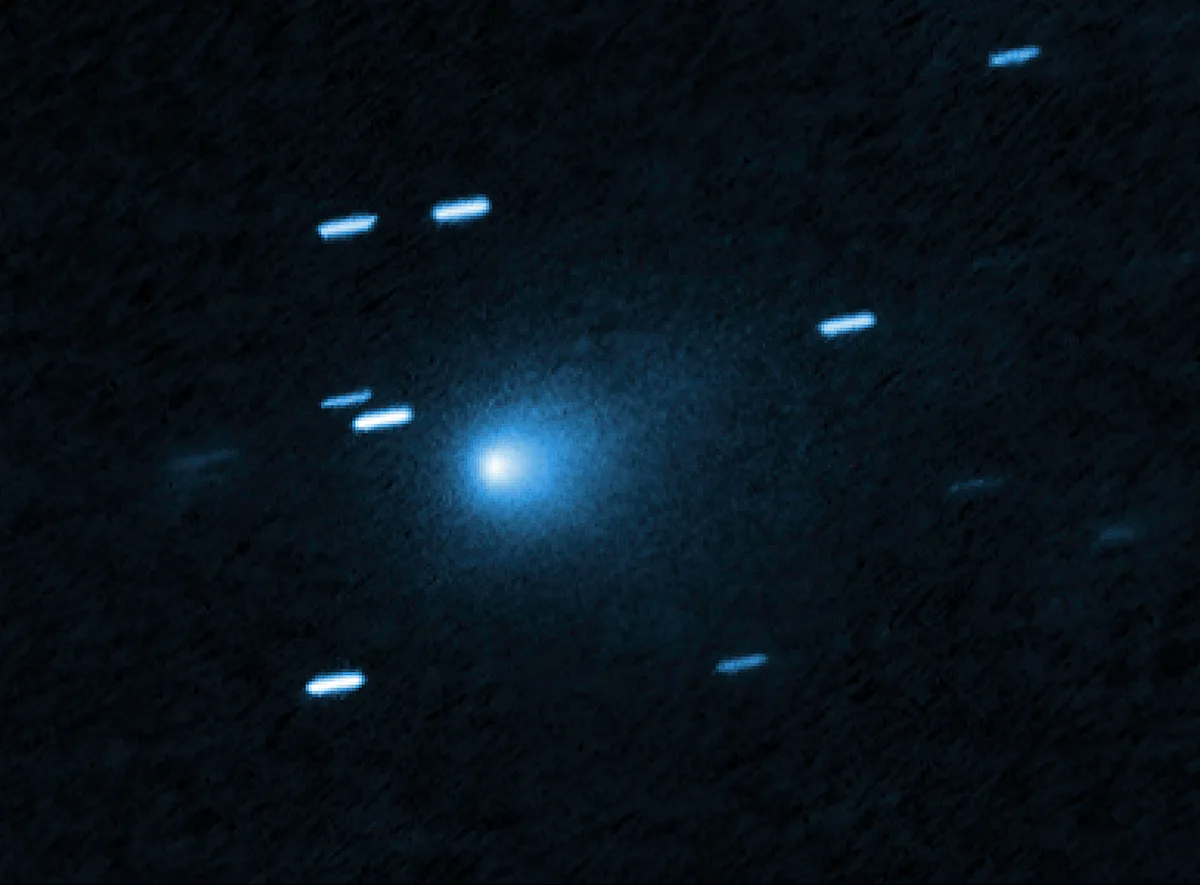
TESS Spotted 3I/ATLAS Two Months Before It Was Discovered – It Was Even Active Then
One of the advantages of having so many telescopes watching large parts of the sky is that, if astronomers find something interesting, there are probably images of it from before it was officially discovered sitting in the data archives of other satellites that noone thought to look at. That has certainly been the case for our newest interstellar visitor, 3I/ATLAS, which, though discovered in early July, had been visible on other telescopes as early as May. We previously reported on Vera Rubin’s detection of 3I/ATLAS well before it was officially found, and now a new paper has found the interstellar object in TESS’s data going back to early May – and it looks like it may have been “active” around that time.
The Transiting Exoplanet Survey Satellite (TESS) isn’t designed to find interstellar visitors, or anything faint for that matter. As its name implies, it is designed to look at stars (which are bright) and watch exoplanets traverse in front of them, watching the host star’s light curve dip as they do. But, data is data, and since TESS happened to be looking at a part of the sky where 3I/ATLAS was supposed to be earlier this year, researchers Adina Feinstein and Darryl Seligman from Michigan State and John Noonan from Auburn decided to see if they could find any data on it in the telescopes archives.
Turns out they could, going as far back as May 7th, 2025, over the course of two separate observational periods. Since TESS captures an image every 200 seconds, and 3I/ATLAS is moving much more quickly than the traditional stars TESS is designed to look at, the team had to use a technique known as “shift-stacking”. They predicted where the interstellar object (ISO) would be in each picture, shifted the pictures so the ISO would be at the same spot in every picture, and then stacked multiple of the pictures together to get a clear signal of an object that would otherwise be too faint to find in a single picture.
Fraser discusses how 3I/ATLAS is showing signs of emitting lots of another thing it would be expected to – water.
3I/ATLAS started the observational period at about 6.35 AU, and moved to about 5.47 AU by the end of a second window on June 2nd. During that time, its flux increased by a factor of 5, though the decrease in distance would have only accounted for an increased brightness about 1.5
There has already been plenty of speculation about what might be causing some of the more interesting features of 3I/ATLAS, ranging from mistakes in data collection to the object itself being alien technology. However, the authors have a much more mundane explanation for this seemingly bizarre occurrence – the ISO was likely outgassing “hypervolatile” materials like carbon dioxide and carbon monoxide. These have a much higher sublimation point than water ice, and can cause a significant increase in brightness, but most of the comets in our own solar system don’t have any hypervolatiles left, so they wouldn’t show the same dramatic increase in brightness that far away from the Sun. To the researchers, this is another data point that comets from other solar systems likely have a very different composition than those bound to ours.
In an effort to find even more differences, they also tried to look at the rotational period of the ISO’s nucleus. However, there wasn’t enough of a clear signal to delineate whether or not the nucleus was actually moving. Most likely this was caused by a coma obscuring any noticeable features, making it hard for TESS to detect any changes in brightness caused by its rotation.
Fraser discusses 3I/ATLAS more generally when it was first discovered.
As we continue to study every new interstellar object that comes across our path, we’ll begin to find out more and more about them. This paper adds to that corpus of knowledge, and there will undoubtedly be more to come as astronomers start sifting through old data on every telescope they can find trying to unlock the mysteries of our enigmatic visitors.
Learn More:
A. Feinstein, J Noonan, & D. Seligman – Precovery Observations of 3I/ATLAS from TESS Suggests Possible Distant Activity
UT – 3I/ATLAS Is Very Actively Releasing Water
UT – Apparently Vera Rubin Captured Images Of 3I/ATLAS Before It Was Even Discovered
UT – Tracking the Interstellar Objects 1I/’Oumuamua, 2I/Borisov, and 3I/Atlas to their Source
Continue Reading
-
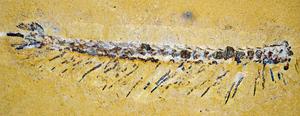
An ancient signpost: Minute fossils tell big story about arthropod evolution
image:
One of several Jianfengia fossil specimens: The animal’s body plan is extremely simple, consisting of numerous identical segments. However, its head is like that of a more modern crustacean, with eyes on stalks and frontal simple eyes. The head is about 2 millimeters wide (less than one tenth of an inch).
view moreCredit: Nick Strausfeld, University of Arizona
A tiny fossil of a sea creature that lived more than half a billion years ago sheds new light on the evolution of arthropods, the most species-rich and successful group of animals to inhabit the Earth, according to a study published in Nature Communications. One of the last remaining enigmas surrounding arthropod evolution has been the split of the tree of life separating the two largest groups of arthropods: mandibulates, the group including insects, crustaceans, millipedes and centipedes; and chelicerates, the group that includes spiders, scorpions and their kin. New analyses of fossils of an extinct segmented creature known as Jiangfengia multisegmentalis reveal that the specimen is crucial in separating the earliest mandibulates from chelicerates.
Led by Nicholas Strausfeld at the University of Arizona’s Department of Neuroscience, a team has revealed minute details of the fossilized brain of Jiangfengia that places it squarely in the ancestry of mandibulates, not chelicerates, as had been previously assumed. Jiangfengia’s classification as an ancestral chelicerate had been based on its paired grasping appendages that extend from its head. That feture had placed it into an assemblage of extinct creatures known as megacheirans — Greek for “large hands.” Two of the most exquisitely preserved megacheiran specimens that lived about 525 million years ago were Jianfengia which alsohad compound eyes and Alalcomenaeu which had fewer segments and two pairs of single lens eyes. Both had been traditionally lumped together as megacheirans with the assumption that their head appendages are the precursors of what became fangs in spiders and their relatives.
According to the research team, the story is more nuanced and complicated. Strausfeld, a Regents Professor at the University of Arizona and a Royal Society Fellow, called their discovery a possible game changer. “These megacheirans didn’t have antennules, which are antenna-like appendages that are common to crustaceans, insects and centipedes,” Strausfeld said. “Instead we see these strange, quite sturdy head appendages that were specialized for reaching and clasping things.”
Paleontologists refer to these hallmark structures of megacheiran fossils as “great appendages.” Their pincer-like ends suggested their similarity with the clasping appendages of Limulus, commonly known as the horseshoe crab, Strausfeld added. Accordingly, the Megacheira were classified as chelicerates, to which Limulus and arachnids also belong.
The research revealed that the fossilized brains of Jianfengia and Alalcomenaeus were in fact not only morphologically distinct from each other but that they typified ancestors of two major arthropod groups, not just one.
Jianfengia’s tiny head, measuring only two millimeters across, is defined by a short, shell-like covering from which extend its pair of “great appendages.” Just in front of these are paired eyestalks, one on each side of the head, which are capped by a small but obvious compound eye like those of insects and crustaceans. The front of Jianfengia‘s head also had at least three single lens “eyes” much like the simple eyes found in many insects and crustaceans.
When Strausfeld’s team reconstructed the fossilized remains of Jianfengia’s nervous system in four fossil specimens, it found a brain, the shape of which corresponds to that of a modern shrimp or crayfish. In addition, it showed elements of the simpler arrangements seen in small freshwater crustaceans such as brine shrimps, also known as “Sea Monkeys,” popular pets that have provided many a child with their first view of a real live crustacean. Taken together, these findings led the researchers to conclude that Jianfengia had previously been misclassified as an early chelicerate, whereas Alalcomennaeus had already been shown to have a Limulus-like brain.
“Our results demonstrate that close examination of fossilized neural remains can provide powerful data indicating evolutionary relationships impossible to obtain just from features of the exoskeleton,” Strausfeld said. “One needs to know what to look for in the fossil brain because it tells us a lot about a fossil’s identity.”
Frank Hirth, a co-author and professor at the University of London’s King’s College, emphasized a crucial aspect of these fossils: “The organization of their fossilized brains perfectly aligns with that of living arthropods, suggesting that their ancient genetic and developmental constituents are extraordinarily robust, yet diverse, which may explain why arthropods are the most successful inhabitants of this planet.”
Co-author Xianguang Hou, professor at the Yunnan Key Laboratory for Palaeobiology of Yunnan University in Kunming, China discovered the first fossil of Jianfengia in 1984. One of the most famous fossil beds documenting life in the Cambrian period, which lasted from about 540 to 480 million years ago, the area in the vicinity of Kunming in China’s Yunnan province was once a shallow sea. Its bounty of ancient life forms very rarely shows evidence of soft tissues, especially neural remains. Since then, about a dozen additional specimens have been found.
Strausfeld pointed out that a fossil’s neural traces can be very subtle, but can be amplified by enhancing the contrast and width of the darkest deposits standing out against the gray granular rock in which the fossil was embedded.
“What we saw was unexpected: the brain looks really modern, comparable to that of a living crustacean,” he said. “In one specimen we even could peer into the compound eyes and look down some of its facets to see fossilized ‘cone cells’ that supported the photoreceptors.”
To further confirm the evolutionary position of Jianfengia, co-author David Andrew of Lycoming College in Williamsport, Pennsylvania used statistical methods to construct so-called phylogenetic trees — essentially family trees — based on neuronal traits, to determine where in the tree of life Jianfengia should be placed.
“Many repeats of these comparisons revealed that in the arthropod tree of life, Jianfengia sat at or near the root of all mandibulates, whereas its putative cousin, Alalcomenaeus, has the same status, but within the chelicerate branch of the tree of life,” Andrew said.
The team concluded that the “great appendages” belonging to Jianfengia later became modified as antennules typifying today’s mandibulates, whereas the “great appendages” of Alalcomenaeus later became modified as the pincer-like fangs typical of today’s chelicerates.
“In chelicerates, these ‘great appendages’ shrunk, so they eventually became the spider fangs,” Strausfeld said. “In mandibulates, evolution modified them into segmented antennules.”
According to Strausfeld, living support for this view comes from the living ostracods, small marine crustaceans sporting antennules tipped with claspers. “It appears that the ’great appendages‘ that we see in our fossils from more than a half billion years ago weren’t completely lost.”
Journal
Nature Communications
Method of Research
Data/statistical analysis
Subject of Research
Not applicable
Article Title
Brain anatomy of the Cambrian fossil Jianfengia multisegmentalis informs euarthropod phylogeny
Article Publication Date
28-Aug-2025
Continue Reading
-

SpaceX launches 33rd cargo mission to the ISS with vital science and supplies
image: ©EyeEm Mobile GmbH | iStock NASA’s latest commercial resupply mission to the International Space Station (ISS) is underway, following the successful launch of SpaceX’s Dragon spacecraft at the end of last week
The uncrewed cargo ship lifted off at 2:45 a.m. on the August 24th EDT aboard a Falcon 9 rocket from Cape Canaveral Space Force Station in Florida, marking the 33rd resupply mission conducted by SpaceX for NASA.
The Dragon spacecraft is carrying more than 5,000 pounds of essential supplies, scientific experiments, and technology demonstrations destined for the orbiting laboratory.
Supporting future space exploration
This mission delivers a wide range of research and materials that support both life on Earth and future deep space missions under NASA’s Artemis program. Artemis aims to return astronauts to the Moon and eventually pave the way for human exploration of Mars.
Among the cargo are several advanced experiments designed to test technologies in microgravity, including 3D printing of metal parts and the bioprinting of tissue. These technologies could one day provide astronauts with tools and even medical support systems during long-duration space missions.
Scientific highlights inboard
Key scientific investigations on this mission include:
- Stem Cell Research: Bone-forming stem cells are being sent to study the prevention of bone loss in microgravity. The research could lead to new treatments for osteoporosis and other bone-related conditions on Earth and in space.
- Bioprinted Liver Tissue: A study will explore blood vessel development in bioprinted human liver tissue. Understanding how tissues grow and function in space could support future regenerative medicine efforts and organ replacement therapies.
- 3D Printing in Microgravity: Supplies to 3D print metal cubes will test the ability to manufacture tools and components in space. This innovation may reduce dependence on Earth-based resupply in the future and enhance in-situ manufacturing on the Moon or Mars.
- Medical Implant Materials: New materials will be tested for use in creating medical implants designed to treat nerve damage. The microgravity environment provides a unique setting to advance the development of such materials.
These investigations are part of hundreds of studies carried out aboard the ISS, which continues to serve as a vital platform for Earth and space science research.
The Dragon spacecraft autonomously docked with the station’s Harmony module around 7:30 a.m. EDT on Monday, August 25. Live coverage of the arrival began at 6 a.m. on NASA+, as well as on streaming platforms such as Netflix and Amazon Prime.
In addition to delivering experiments and supplies, the Dragon spacecraft will perform a key station maintenance task. It will demonstrate a reboost manoeuvre using an independent propulsion system housed in the spacecraft’s trunk. This system, which uses Draco engines, is designed to help maintain the ISS’s altitude. A series of planned orbital boosts will commence in September and continue through the fall of 2025.
This will be the second example of these capabilities. The first test was conducted during SpaceX’s 31st commercial resupply mission in November 2024.
Return to Earth in December
The Dragon spacecraft will remain attached to the station until December. At the end of its mission, it will undock and return valuable scientific samples and cargo to Earth, landing via splashdown off the coast of California.
The ongoing partnership between NASA and SpaceX continues to deliver critical resources to the ISS, while enabling cutting-edge research that benefits humanity and prepares for the challenges of future space exploration.
Continue Reading
-
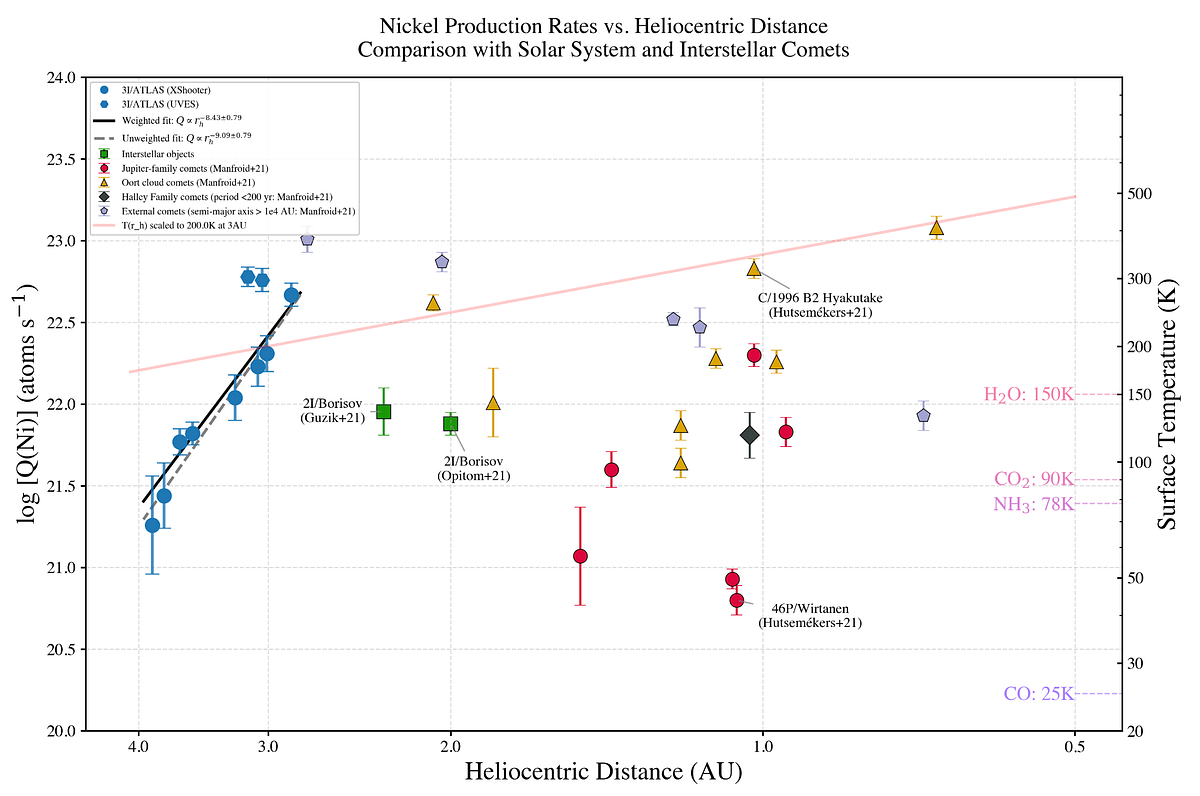
A Steeply-Rising Production of Cyanide and Nickel Without Iron in the Gas Plume Around 3I/ATLAS | by Avi Loeb | Aug, 2025
Press enter or click to view image in full sizeLogarithm of the nickel mass loss rate from 3I/ATLAS (vertical axis) as a function of heliocentric distance (horizontal axis). Blue circles show Very Large Telescope/X-shooter measurements of 3I/ATLAS and the black solid curve is a power–law fit to the data with a power-law index of −8.43±0.79. Colored symbols compare with Solar–system comets compiled from the literature. (Credit: R. Rahatgaonkar et al. 2025) A new paper on spectroscopic data from the Very Large Telescope (accessible here) reported the surprising detection of nickel without iron in the plume of gas around 3I/ATLAS. Nickel without iron is a signature of industrial production of nickel alloys. This data constitutes a new anomaly of 3I/ATLAS. Natural comets generically show iron and nickel simultaneously, as both elements are produced together in the ejecta of supernova explosions.
Is this anomaly another clue for a possible technological origin of 3I/ATLAS? The paper suggests chemical formation through the nickel carbonyl channel which is an extremely rare and exotic possibility in comets, whereas it is a standard technology for industrial nickel refining.
The inferred mass loss rate of nickel for 3I/ATLAS is about 5 grams per second at a heliocentric distance of 2.8 times the Earth-Sun separation (AU). It exhibits a dramatic rise with decreasing distance from the sun, with a power-law index of -8.43 (+/-0.79).
The spectroscopic data on the plume surrounding 3I/ATLAS also reveals cyanide (CN), with a mass loss rate of about 20 grams per second at 2.85 AU and an even steeper dependence on heliocentric distance to the power of -9.38 (+/-1.2).
These results add to the chemical anomalies implied by the SPHEREx space observatory (here) and Webb space telescope (here), which revealed that the gas plume around 3I/ATLAS is dominated by mass with 95% of CO2 and only 5% of H2O, very different from an expected water-rick comet. The idea that nucleus is much smaller than the 46-kilometer diameter inferred from the 1-micron data collected by SPHEREx, requires a dense coma of dust to reflect nearly all the sunlight from 3I/ATLAS. In that case, the dust would have been pushed by solar radiation pressure to trail the nucleus, constituting a prominent cometary tail. However, no cometary tail was observed around 3I/ATLAS in the Hubble Space Telescope image (available here), which extended backward as much as it extended sideways, perpendicular to the direction of the Sun.
If, on the other hand, most of the sunlight is reflected by the surface of the nucleus, the 3I/ATLAS is a million times more massive than the previous interstellar object 2I/Borisov. We should have detected a million objects of the scale of 2I/Borisov before detecting a 46-kilometer nucleus if 3I/ATLAS was a rock on a random trajectory. The fine-tuned alignment of the trajectory of 3I/ATLAS with the ecliptic plane of the planets (discussed here) suggests that it may have targeted the inner solar system by technological design, as I suggested in a paper written a few days after 3I/ATLAS was discovered (accessible here).
I am writing this report from Copenhagen, where I was invited to give a lecture at a conference titled “Current Themes in Astrophysics and Particle Physics 2025,” and attended by Nobel laureate David Gross and other leading physicists and astrophysicists.
Press enter or click to view image in full sizeParticipants at the Copenhagen Conference in 1930, photographed in Auditorium A at the Niels Bohr Institute. Four of them received the Nobel Prize in Physics (which Bohr was awarded in 1922) while five were awarded the Max Planck medal. Two played a key role in the Manhattan Project which led to the production of the first atomic bomb. Seated in the front row are Niels Bohr (second from left) to the left of Werner Heisenberg and Wolfgang Pauli and Lev Landau is second from the right. (Credit: Niels Bohr Arkivet) Copenhagen is well known to physicists as the birth place of the Copenhagen interpretation of quantum mechanics. When I entered Auditorium A at the Niels Bohr Institute, the room looked familiar. I remembered a photograph of this auditorium from 1930, which showed at the front row Niels Bohr, Werner Heisenberg, Wolfgang Pauli and Lev Landau who pioneered quantum mechanics. Niels Bohr debated Albert Einstein about the proper interpretation of quantum mechanics and his view on indeterminism, the irreversibility of quantum measurements, and complementarity — that objects have certain pairs of complementary properties which cannot all be observed or measured simultaneously, prevailed to form the modern understanding of physics.
As soon as I chose a seat at the center of the wooden bench, I was informed that I just sat where Wolfgang Pauli sat 95 years ago. But all that I could think about at that moment is how uncomfortable the seating bench is and how much worse the quality of life must have been for these luminaries a century ago. Nevertheless, I would have happily traded being at the same room 95 years ago, when the excitement of discovery was routine and deviations from traditional thinking was celebrated rather than being ridiculed on social media.
My lecture (accessible here) was split into two parts: black holes and interstellar objects. The second part was added at the last minute based on a request from members of the audience during the coffee break.
In the spirit of the 1930 photograph, I enjoyed the lively discussion on 3I/ATLAS. In the Q&A segment that followed my lecture, excited members of the audience that filled the room with some standing in the back, asked numerous questions about 3I/ATLAS. David Gross was interested about messaging 3I/ATLAS, why it sheds CO2 if it is technological, and whether there is any evidence for a non-gravitational acceleration. The conference organizers, Emil Bohr and Johan Samsing noted: “What a wonderful and refreshing talk.” For a rare moment in my 45-year career in physics, I had felt a sense of genuine curiosity and the spirit of an authentic discussion of all possibilities. This was the spirit that brought me to physics in the first place. Auditorium A delivered what I expected from it. The stiff wooden bench on which we all sat did its job. It is a metaphor to the stubborn facts that revolutionized our perception of the physical world when quantum mechanics was discovered, and that would revolutionize our mental world when we encounter alien technology.
On October 3, 2025, 3I/ATLAS will pass within 29 million kilometers from and the HiRISE camera onboard the Mars Reconnaissance Orbiter which will be able to image it with a 30 kilometer per pixel resolution. Such an image could separate the contributions of the nucleus and coma to the reflected sunlight and constrain with greater confidence the size of the nucleus.
David Gross suggested that we should also observe 3I/ATLAS with radio telescopes for any technological radio transmission coming from it. I agree. This encounter is a blind date of interstellar proportions, and on any blind date my best advice is: “Observe the other side.” We had already revealed our existence by broadcasting radio signals for over a century. This act might have triggered the visit. If 3I/ATLAS had originated from the inner edge of the Oort Cloud at about 2,000 times the Earth-Sun separation, it would have started its journey when radio transmissions started on Earth.
On the one hand I would be pleased if 3I/ATLAS turned out to be a CO2-rich comet, implying that humanity is not be at risk from alien technology, but on the other hand — humanity desperately needs a wake-up call to avoid self-destruction.
During the coffee break, the brilliant Alex Lupsasca told me about his recent mathematical discovery of three new symmetries in black holes spacetimes (discussed here). After laboring to discover them, Alex asked ChatGPT to find these symmetries and was shocked to find out that the latest version of this Artificial Intelligence (AI) system managed to accomplish the same task swiftly. He later verified with OpenAI that the AI system did not have access to his paper as it was trained on older data. Perhaps super-human intelligence is already among us.
Of course, alien AI might supersede our own digital creations. If any future interstellar object will end up as technological technology, ranking 10 on the Loeb Scale, we should be filled with gratitude for the Universe endowing us, once again, with a much-needed sense of cosmic modesty.
ABOUT THE AUTHOR
Press enter or click to view image in full size(Image Credit: Chris Michel, National Academy of Sciences, 2023) Avi Loeb is the head of the Galileo Project, founding director of Harvard University’s — Black Hole Initiative, director of the Institute for Theory and Computation at the Harvard-Smithsonian Center for Astrophysics, and the former chair of the astronomy department at Harvard University (2011–2020). He is a former member of the President’s Council of Advisors on Science and Technology and a former chair of the Board on Physics and Astronomy of the National Academies. He is the bestselling author of “Extraterrestrial: The First Sign of Intelligent Life Beyond Earth” and a co-author of the textbook “Life in the Cosmos”, both published in 2021. The paperback edition of his new book, titled “Interstellar”, was published in August 2024.
Continue Reading
-
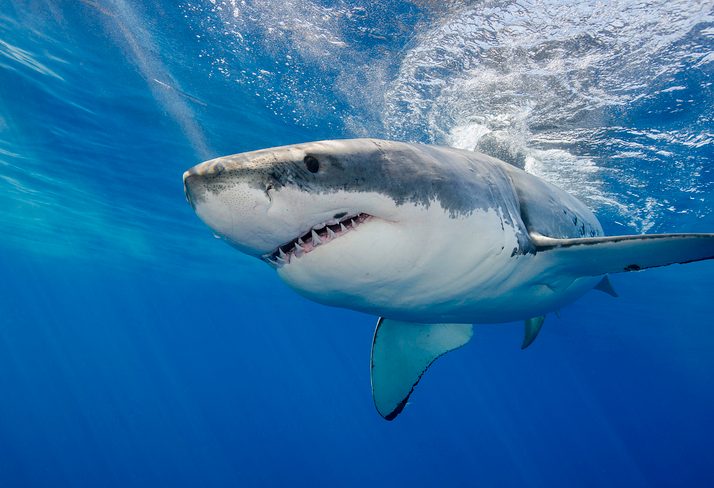
Toothless killers: sharks are losing their deadliest weapon, say researchers. And they know why
Sharks rely on their razor-sharp teeth – replaced every few days to ensure maximum killing power – to survive. But this weapon is under threat, which could spell disaster for one of the ocean’s top predators.
Maximilian Baum with a blacktip reef shark jaw at the aquarium. Credit: Roman Müller-Böhm The more carbon dioxide humans release into the atmosphere, the more the ocean absorbs. With increased absorption of carbon dioxide, the ocean becomes more acidic, and by 2300 the sea is projected to be ten times more acidic than it currently is. This is likely to be catastrophic for animals such as corals and shellfish, but how this acidification might affect top predators isn’t well understood.
A new study, published in Frontiers in Marine Science, explores the impact ocean acidification will have on sharks by focussing in on one of their most important survival tools: their teeth.
The researchers collected newly shed teeth from captive blacktip reef sharks. Blacktip reef sharks must swim with their mouths open – and their teeth exposed – in order to breathe, and their teeth are therefore extremely vulnerable to the effects of ocean acidification. By placing the collected teeth in acidified seawater, the scientists could observe what might happen to shark teeth in the near future.
The results are not good news for sharks. In more acidic seawater, shark teeth begin to crumble. They develop cracks and holes, and the roots corrode. But what does this mean for the ocean’s top predators?
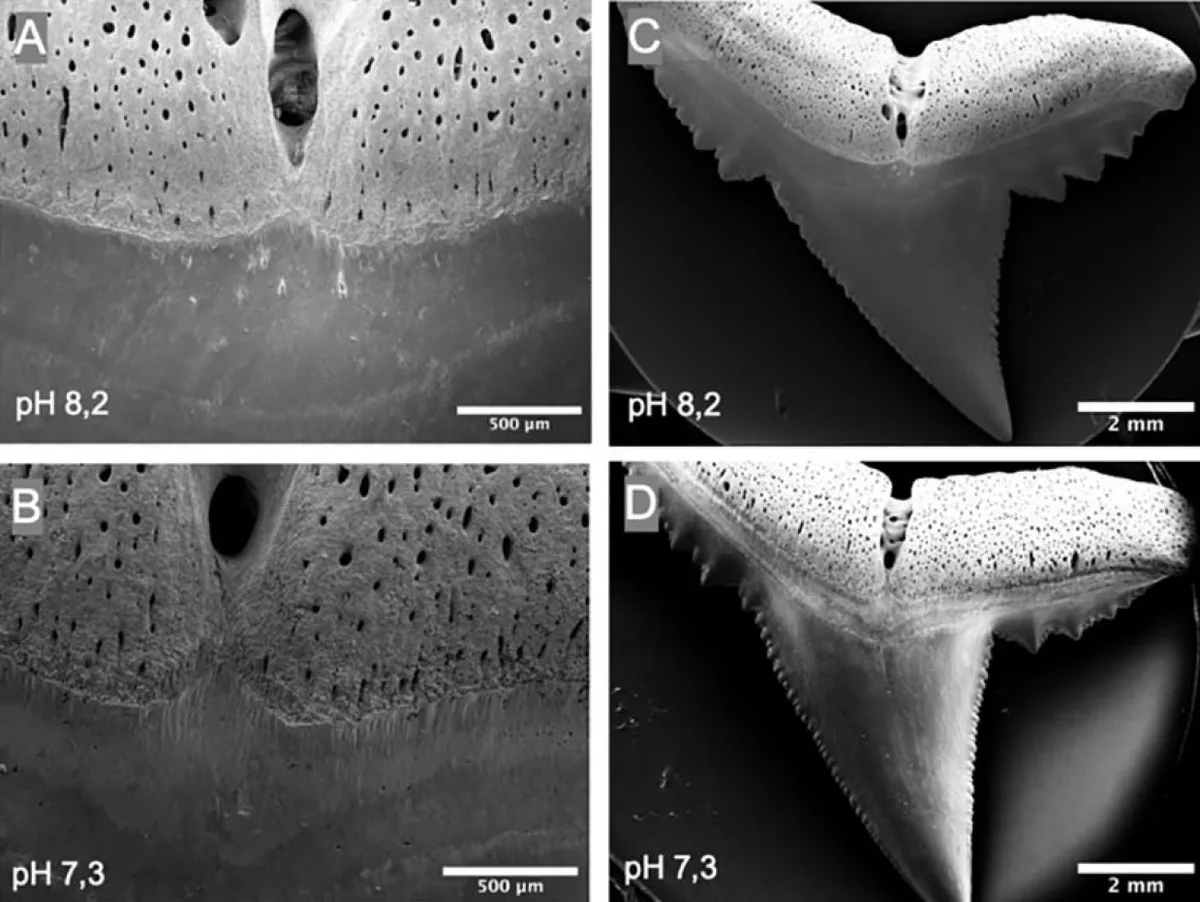
Figure 5: SEM analyses of osteodentin corrosion at C. melanopterus teeth. (A-D) Representative SEM images of teeth and basal sections incubated at pH 7.3 and pH 8.2, respectively. Credit: Steffen Köhler “Damaged teeth may reduce feeding efficiency,” Maximilian Baum, lead author of the study, tells BBC Wildlife. “Over time, this could affect their hunting success, fitness and ecological role.”
There is a possibility that sharks might be able to repair their teeth by remineralising them. While costly, this would increase the sharks’ chances of surviving ocean acidification.
Unfortunately, it is not only acidification that sharks have to contend with.
“Acidification adds to many other human-driven stressors like overfishing, pollution and habitat loss,” Maximilian says. “The speed and scale of change may outpace their ability to adapt.”
Discover more amazing wildlife stories from around the world
Top image: a great white shark. Credit: Getty
Continue Reading
-

China’s ‘Darwin Monkey’ is the world’s largest brain-inspired supercomputer
Scientists in China have unveiled a supercomputer built on brain-like architecture — specifically, that of a monkey.
Called Darwin Monkey or “Wukong”, the system features over 2 billion artificial neurons and more than 100 billion synapses, putting it roughly on par with the neural structure of a macaque.
The researchers hope it will serve as a simulation tool for neuroscientists while also providing a stepping stone toward artificial general intelligence (AGI) — an artificial intelligence (AI) system that possesses human-like intelligence and reasoning.
Br(AI)n power
Unlike traditional artificial neural networks, which follow classical computing principles and process data via continuously changing binary values, neuromorphic systems like Darwin Monkey are driven by spiking neural networks (SNNs).
SNNs mimic how signals are transmitted between neurons in the brains of mammals, responding to electrical signals to process and transmit data through on-and-off bursts (or spikes) of activity.
Related: China develops new light-based chiplet that could power artificial general intelligence — where AI is smarter than humans
A biological neuron fires an electrical pulse when the signals it receives from other neurons reach a level strong enough to trigger a response. Artificial neurons in SNNs mimic this mechanism, firing only when they’ve built up enough electrical input.
Where software-based neural networks are a collection of machine learning algorithms arranged to emulate the human brain, SNNs physically replicate the way information moves between biological neurons. This configuration allows SNNs to process data in parallel, potentially making them more powerful than conventional supercomputer architectures.
It may also be more energy efficient: artificial neurons enter a brief rest period after each spike, during which they can’t respond to new inputs. This limits how often they fire, helping to reduce overall power consumption.
Researchers say Darwin Monkey consumes just 2,000 watts of power — roughly the equivalent of an electric kettle or hairdryer — despite being powered by 960 Darwin III neuromorphic chips, each of which supports up to 2.35 million spiking neurons.
Other neuromorphic computers
The previous record-holder in neuromorphic computing was Intel’s Hala Point system, which comprises 1.15 billion artificial neurons and 128 billion artificial synapses distributed over 140,544 processing cores.
Intel claims its system is capable of performing 20 quadrillion operations per second — or 20 petaops. But as there are very few neuromorphic computers currently in existence, and as they process data differently from supercomputers, it’s difficult to compare them on a like-for-like basis.
In a statement, translated into English using Google Translate, the team behind Darwin Monkey said the platform had already demonstrated its capabilities in cognitive tasks such as logical reasoning, content generation and mathematical problem-solving, using an AI model developed by Chinese AI startup DeepSeek.
The system is also being used to simulate the brains of animals with varying levels of neural complexity, including zebrafish and mice, as part of broader efforts to support brain science research.
Darwin Monkey was designed by researchers from Zhejiang University and Zhejiang Lab, a research institute jointly established by the Zhejiang provincial government and Alibaba Group, a Chinese technology conglomerate.
It follows the launch of Darwin Mouse (“Mickey”) in September 2020, which contains 120 million artificial neurons — the equivalent of a mouse’s brain.
Continue Reading